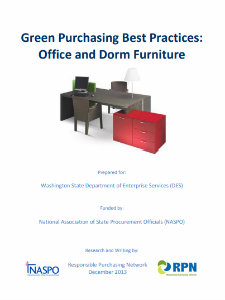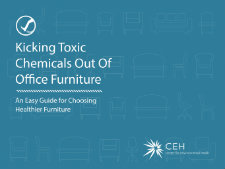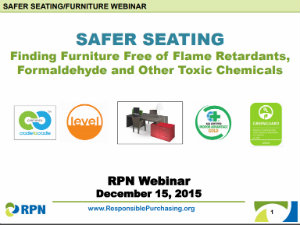Furniture
 |
The market for environmentally preferable furniture is relatively mature. There are many certified lowemitting products on the market and manufacturers are beginning to make significant changes to their existing product lines and introduce new product lines that reduce health and environmental impacts. Unfortunately, many traditional office and school furniture products contain harmful chemicals in the adhesives, finishes, foams, fabrics, and other materials that could significantly impact public health. They may also use a large amount of virgin resources, from wood to plastics. As the industry has matured, it is now relatively easy to find greener alternatives that are comparable on performance, style, and price as manufacturers continue to make efforts to make their products more environmentally preferable.
Resources
 |
RPN - Green Purchasing Best Practices: Office and Dorm Furniture – Dec 2013This RPN guide discusses the environmental and health benefits of green office and school furniture, availability and performance issues, green certifications and standards, purchasing requirements for environmental preferability, product and vendor selection, and lifecycle costs. |
 |
Center for Environmental Health - Kicking Toxic Chemicals Out of Office Furniture - May 2017This guide offers a brief introduction to chemicals we call the “Hazardous Handful” and provides tips for how you can avoid these hidden health dangers when purchasing furniture for your office, business, or school. The guide includes a list of manufacturers selling office furniture without the Hazardous Handful chemicals, a discussion of certification programs and standards for furniture, and tips for how to make the business case for healthier furniture. |
 |
Healthier Hospitals - List of Furniture and Materials that Meet the HH Healthy Interiors Goal – Jan 2016Healthier Hospitals (HH) makes it easier for hospitals to select furniture and materials that meet the Healthy Interiors goal of the Safer Chemicals Challenge. HH worked with furniture and textile manufacturers to identify products that meet the Healthy Interiors goal. An important note: this is NOT a certification, and Healthier Hospitals does NOT verify this information. Hospitals are encouraged to seek verification from individual manufacturers. |
Webinars
 |
RPN/CEH Webinar: Toxic Chemicals in Disposable Food Service Ware - October 17, 2017Furniture is often made with chemicals and materials that are hazardous to the people who manufacture it, use it, and recycle it. This includes substances that are linked to cancer, asthma, decreased fertility, or other diseases. Of greatest concern are formaldehyde, flame retardants, fluorinated stain resistance chemicals, antimicrobials, and vinyl. This doesn't sit well with us. Hear how purchasing agents and advocates are working together to identify the chemical hazards that are lurking in (and on) office chairs, couches, desks, and other types of furniture. And learn about new regulations and tools that are making it easier to find safer and healthier furniture products. This webinar featured:
|

